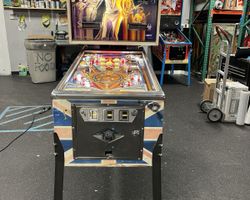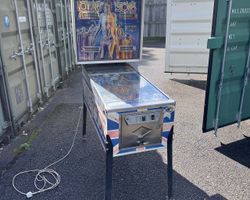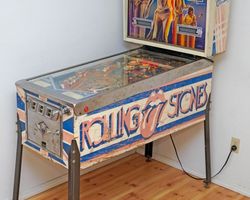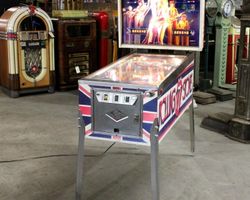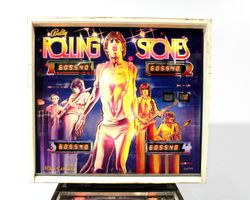Rolling Stones
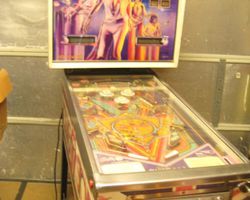
Average Prices: USD $500 to $3,600
Produced: May, 1980
Production Run: 5,700 units
Machine Type: Solid State Electronic
MPU: Bally MPU AS-2518-35
Players: 4
Design by: Jim Patla
Art by: Greg Freres
Bally Manufacturing Corporation released Rolling Stones in May 1980, a solid-state electronic pinball machine that married the burgeoning pinball industry with the global appeal of one of rock and roll's most enduring acts. This collaboration marked a significant venture for Bally into licensed themes, aiming to capitalize on the band's recognition to attract a broader audience. As an early entry in the solid-state era, Rolling Stones navigated the technical limitations and creative freedoms of its time, presenting a distinct experience for players and collectors.
History and Background
The development of the Rolling Stones pinball machine was a collaborative effort within Bally. Jim Patla, known for his work on several Bally titles, took on the design responsibilities, shaping the fundamental playfield layout and shot geometry. Greg Freres, a prominent artist in the pinball industry, was tasked with bringing the band's image to the machine's visual elements. Rehman Merchant contributed the software, programming the logic and scoring systems that defined gameplay.
The machine's production run totaled 5,700 units, making it a moderately produced title for the era. One notable detail from its production involves the cabinet artwork. Early production models of the Rolling Stones cabinet displayed the band's name in blue letters, alongside a blue depiction of their signature "tongue and lips" logo. The Union Jack flag, featured prominently on the cabinet front, also presented incorrect colors, with red and blue reversed from their proper orientation. This misprint was corrected during the production run, resulting in later cabinets featuring the band's name and tongue logo in red, with the Union Jack rendered in its correct colors. Greg Freres, the artist, intended the tongue to be red from the outset, and the cabinet front to accurately represent the Union Jack, a testament to the challenges of ensuring visual fidelity in early mass production.
Signature Features and Design
Rolling Stones incorporates several design elements characteristic of early solid-state pinball machines, while also attempting to integrate its musical theme. The machine features two flippers, positioned at the standard lower playfield. The upper playfield includes three pop bumpers, designed to keep the ball in motion and increase scoring opportunities in the top half of the layout. Two slingshots flank the flippers, providing reactive kick-outs that add to the game's dynamic flow.
A prominent interactive feature is the "Satisfaction" target. When activated, this specific stand-up target triggers a brief musical rendition of the band's iconic song. While limited by the primitive sound technology of 1980, this integration offered a direct thematic connection to the band through an auditory reward, a novelty for its time. The cabinet artwork, despite its initial production variations, aimed to capture the band's identity, primarily through the Union Jack motif and the stylized rendering of the band members.
Playfield and Mechanics
The playfield of Rolling Stones is designed for a fast-paced game, emphasizing shot accuracy and flow. The layout includes five stand-up targets and a combination of drop targets: a four-bank of drop targets and an additional solitary drop target. These targets are central to spelling out bonus-enhancing words or advancing game modes. Two horseshoe lanes provide satisfying, looping shots that can be challenging to hit consistently but reward precise aiming. Two star rollovers are positioned to offer further scoring opportunities as the ball traverses the upper playfield. A kick-out hole adds another interactive element, typically collecting the ball and then launching it back into play from a specific location, often tied to a scoring objective or bonus.
The game's flow prioritizes keeping the ball active. The arrangement of targets and lanes encourages players to learn the trajectories for repeated successful shots, particularly the horseshoe loops which are frequently highlighted by players as key to maintaining ball control and building scores. The artwork on the playfield, while a point of discussion among players, presents the band members and a vibrant, concert-like aesthetic. The lighting, typical for its era, uses incandescent bulbs to highlight targets and features, creating a functional yet energetic visual experience during gameplay. The overall aesthetic aims to immerse the player in the world of the band, even within the technical constraints of early solid-state displays and limited color palettes.
Gameplay Dynamics
The gameplay of Rolling Stones is driven by a straightforward yet engaging rule set that rewards target completion and strategic shot selection. A core objective involves spelling out the letters "R-O-C-K" through various playfield actions. Successfully spelling "R-O-C-K" significantly increases the bonus multiplier, a central component of the game's scoring system. This mechanic encourages players to focus on completing specific target banks or sequences to maximize their end-of-ball bonus. The unique bonus multiplier system is frequently cited as a compelling aspect of the game's design.
Beyond the "R-O-C-K" sequence, players are tasked with hitting drop targets, stand-up targets, and the horseshoe lanes to accumulate points and advance towards the bonus. The solitary "Satisfaction" target offers a distinct audio cue, acting as a direct reward for hitting a specific objective. The scoring, though sometimes perceived as imbalanced due to the limitations of the era's digital displays, encourages consistent play and target acquisition. The machine's fast pace and reliance on accurate shots contribute to its "one more game" appeal for many players, providing a challenging experience where precise control is paramount. While the sound system, based on early sound ROM technology, could not reproduce actual Rolling Stones songs due to licensing and technological limitations of the time, the machine relied on original compositions and effects to provide auditory feedback.
Reception and Legacy
The Rolling Stones pinball machine has garnered a varied reception from the pinball community over time. Its gameplay is frequently cited as a strength. Players often praise its fast, challenging nature, highlighting the satisfaction derived from consistently hitting the horseshoe loops and other demanding shots. The ruleset, particularly the distinctive bonus multiplier system and the "R-O-C-K" spell-out, is considered engaging and adds depth to the scoring strategy. For many, the machine possesses an addictive quality, prompting repeated plays in pursuit of higher scores or better performance. The machine's production quantity of 5,700 units also contributes to its collectibility, especially for those who appreciate early Bally solid-state games or are fans of the band.
Conversely, the machine's aesthetics, particularly the artwork, have drawn significant criticism. The playfield and backglass depictions, including the portrayal of Mick Jagger, are often described as uninspired, dull, or even visually unappealing by some players. Another common point of contention is the sound design. Due to the primitive sound ROM technology available in 1980, the machine was unable to feature actual Rolling Stones songs, relying instead on generic electronic tunes and effects. This absence of the band's recognizable music is a frequent lament among players who expect a thematic auditory experience. Some also note that the gameplay, while initially engaging, can become repetitive over extended periods, and that the scoring system, with its limited display digits, occasionally feels restricted.
Despite these criticisms, Rolling Stones holds a place within pinball history as an early example of a licensed music theme from a major manufacturer during the solid-state transition. While not universally acclaimed, its gameplay is regarded as a challenging and enjoyable experience for those who appreciate the design philosophies of the early 1980s Bally machines. Its legacy is perhaps best understood as a machine that successfully combined a globally recognized brand with the mechanics of the era, even as it contended with the technological and artistic limitations of its time.
Sponsored Links
 Ebay Listings
Ebay Listings
 Auction Results
Auction Results
| Cost | Location | Date |
|---|---|---|
| USD $4,000 |  Florida, United States Florida, United States |
11 October, 2025 |
| GBP £3,062 |  Derby, United Kingdom Derby, United Kingdom |
22 September, 2025 |
| USD $1,300 |  Minnesota, United States Minnesota, United States |
22 April, 2025 |
| USD $1,300 |  Minnesota, United States Minnesota, United States |
22 April, 2025 |
| USD $5,889 |  Florida, United States Florida, United States |
19 April, 2025 |
| USD $825 |  Oregon, United States Oregon, United States |
10 January, 2025 |
| USD $4,999 |  California, United States California, United States |
10 March, 2024 |
| CAD $4,500 |  Canada Canada |
20 November, 2023 |
| USD $6,499 |  California, United States California, United States |
13 November, 2023 |
| USD $1,300 |  Nevada, United States Nevada, United States |
29 October, 2023 |


Private Policy · Search Website · Contact Us
As an eBay Partner, we may earn a commission from qualifying purchases made through links on this site, at no additional cost to you.
All trademarks and copyrighted materials remain property of their respective owners. All other content copyright 2007 - 2025 Pinpedia.

